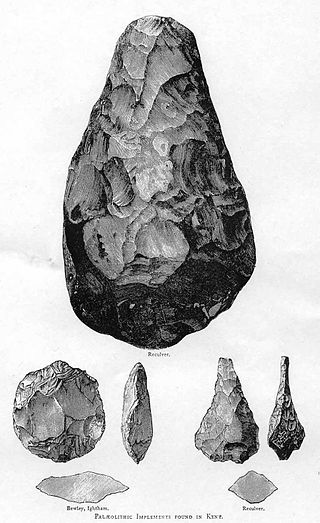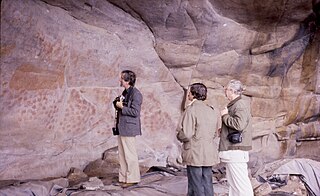Geoff Bailey is a British archaeologist. He currently holds the Anniversary Chair at the University of York in England. His research interests include palaeoeconomy and the archaeology of shell middens and prehistoric coastlines as well as maritime environments as used by humans.

In archaeology, a tell is an artificial topographical feature, a mound consisting of the accumulated and stratified debris of a succession of consecutive settlements at the same site, the refuse of generations of people who built and inhabited them and natural sediment.

The Bhimbetka rock shelters are an archaeological site in central India that spans the Paleolithic and Mesolithic periods, as well as the historic period. It exhibits the earliest traces of human life in India and evidence of the Stone Age starting at the site in Acheulian times. It is located in the Raisen District in the Indian state of Madhya Pradesh, about 45 kilometres (28 mi) south-east of Bhopal. It is a UNESCO World Heritage Site that consists of seven hills and over 750 rock shelters distributed over 10 km (6.2 mi). At least some of the shelters were inhabited more than 100,000 years ago.

The Xagħra Stone Circle, also known as the Xagħra Hypogeum or the Brochtorff Circle, is a Neolithic funerary complex located in Xagħra, Gozo, Malta. It consists of a series of caves which were used to bury the dead, and which were surrounded by a walled enclosure. It mainly dates back to around 3000 to 2400 BC, although the earliest tombs at the site date back to 4100 to 3800 BC. The caves collapsed sometime before 2000 BC, and the site was later used for domestic and agricultural purposes.

The Varna Necropolis, or Varna Cemetery, is a burial site in the western industrial zone of Varna, internationally considered one of the key archaeological sites in world prehistory. The oldest gold treasure and jewelry in the world, dating from 4,600 BC to 4,200 BC, was discovered at the site. Several prehistoric Bulgarian finds are considered no less old – the golden treasures of Hotnitsa, Durankulak, artifacts from the Kurgan settlement of Yunatsite near Pazardzhik, the golden treasure Sakar, as well as beads and gold jewelry found in the Kurgan settlement of Provadia – Solnitsata. However, Varna gold is most often called the oldest since this treasure is the largest and most diverse.
Harvey Weiss is an archaeologist who teaches at Yale University.

André Leroi-Gourhan was a French archaeologist, paleontologist, paleoanthropologist, and anthropologist with an interest in technology and aesthetics and a penchant for philosophical reflection.
Prehistoric Armenia refers to the history of the region that would eventually be known as Armenia, covering the period of the earliest known human presence in the Armenian Highlands from the Lower Paleolithic more than 1 million years ago until the Iron Age and the emergence of Urartu in the 9th century BC, the end of which in the 6th century BC marks the beginning of Ancient Armenia.
Steven Mithen, is an archaeologist. He is noted for his work on the evolution of language, music and intelligence, prehistoric hunter-gatherers, and the origins of farming. He is professor of early prehistory at the University of Reading.

Prehistory, also called pre-literary history, is the period of human history between the first known use of stone tools by hominins c. 3.3 million years ago and the beginning of recorded history with the invention of writing systems. The use of symbols, marks, and images appears very early among humans, but the earliest known writing systems appeared c. 5,200 years ago. It took thousands of years for writing systems to be widely adopted, with writing having spread to almost all cultures by the 19th century. The end of prehistory therefore came at different times in different places, and the term is less often used in discussing societies where prehistory ended relatively recently.
George J. Armelagos was an American anthropologist, and Goodrich C. White Professor of Anthropology at Emory University in Atlanta, Georgia. Armelagos significantly impacted the field of physical anthropology and biological anthropology. His work has provided invaluable contributions to the theoretical and methodological understanding human disease, diet and human variation within an evolutionary context. Relevant topics include epidemiology, paleopathology, paleodemography, bioarchaeology, evolutionary medicine, and the social interpretations of race, among others.
Prehistoric technology is technology that predates recorded history. History is the study of the past using written records. Anything prior to the first written accounts of history is prehistoric, including earlier technologies. About 2.5 million years before writing was developed, technology began with the earliest hominids who used stone tools, which they first used to hunt food, and later to cook.

Prehistoric art in Scotland is visual art created or found within the modern borders of Scotland, before the departure of the Romans from southern and central Britain in the early fifth century CE, which is usually seen as the beginning of the early historic or Medieval era. There is no clear definition of prehistoric art among scholars and objects that may involve creativity often lack a context that would allow them to be understood.

The following outline is provided as an overview of and topical guide to prehistoric technology.

John Parkington is an Emeritus professor in archaeology and hunter-gatherers, Paleoenvironmental reconstruction and human ecology, prehistoric art, and coastal archaeology. He has suggested that since fish provide an important nutrient for the brain, the consumption of fish led to the emergence of the first really intelligent humans in the Western Cape region of South Africa. In February 2000 South African President Thabo Mbeki mentioned the letter he had received from Parkington, regarding the protection of archaeological heritage sites, in his address at the opening of South Africa's Parliament.

Pavel Dolukhanov was a doctor of geographical sciences, professor, emeritus professor (2002), Russian and British paleogeographer and archaeologist at the Institute of History of Material Culture (IHMC), RAS (1959–1989) and the University of Newcastle, United Kingdom (1990–2009), a specialist in archaeology and paleoenvironment of Northern Eurasia. He taught and made research at the Leningrad State University, the University of Newcastle (UK), the Institute of Paleontology in Paris and the International Research Center.

The El Mirón Cave is a large cave in the upper Asón River valley towards the eastern end of Cantabria in northern Spain, near the border of the Basque country. It is an archeological site in Ramales de la Victoria. It is known for a skeleton belonging to a woman nicknamed The Red Lady of El Mirón. She is estimated to have died around 18,700 years ago, during the Upper Paleolithic (Magdalenian). The skeleton is estimated to be that of a woman between 35 and 40 years. Her bones were coated with ochre, a red iron-based pigment, hence, her name.
This page is a glossary of archaeology, the study of the human past from material remains.

Prehistoric religion is the religious practice of prehistoric cultures. Prehistory, the period before written records, makes up the bulk of human experience; over 99% of human experience occurred during the Paleolithic period alone. Prehistoric cultures spanned the globe and existed for over two and a half million years; their religious practices were many and varied, and the study of them is difficult due to the lack of written records describing the details of their faiths.
Malin Holst is a German bioarchaeologist, Director of York Ostoearchaeology Ltd. and a lecturer in the Department of Archaeology at the University of York.